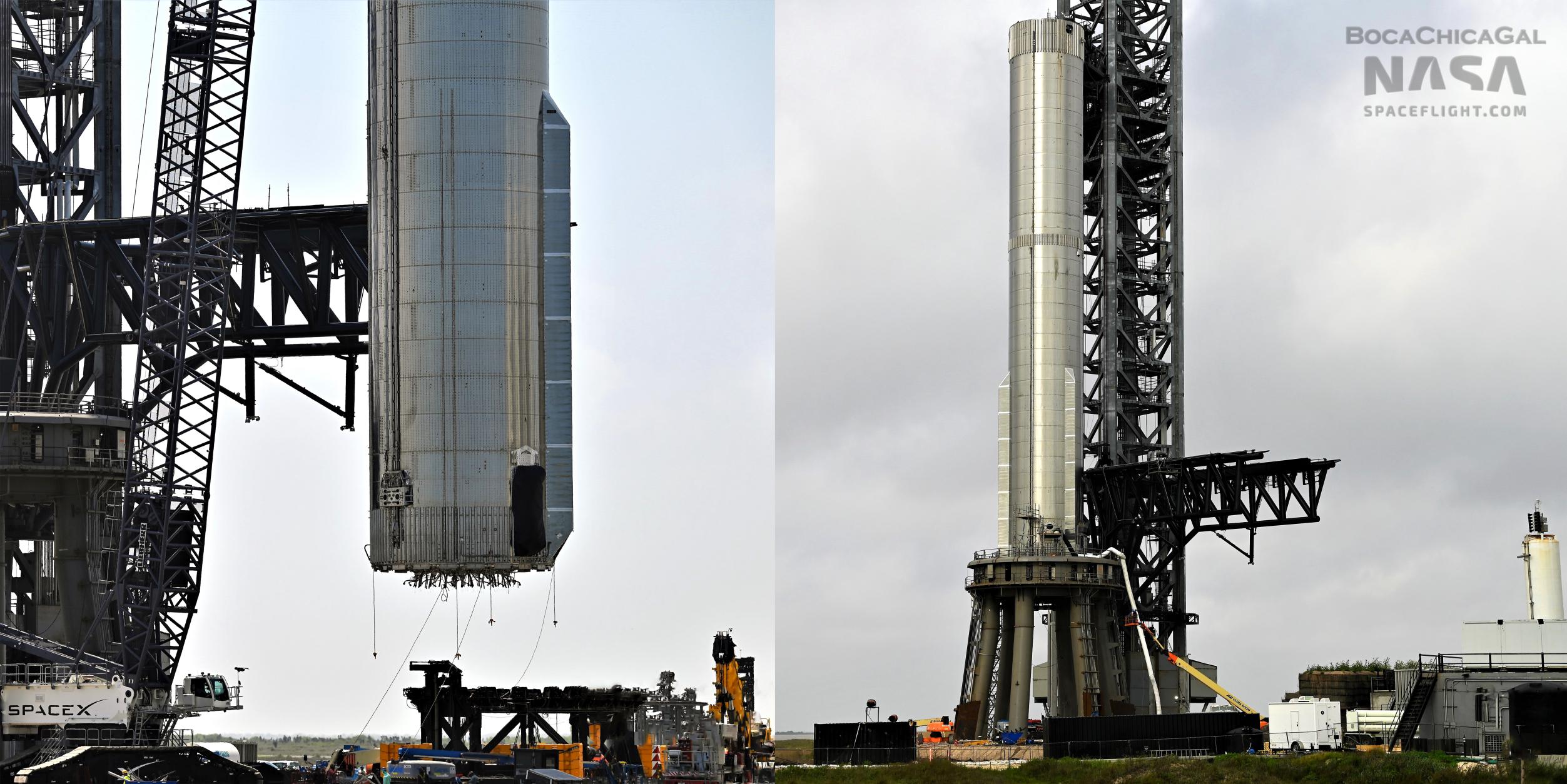
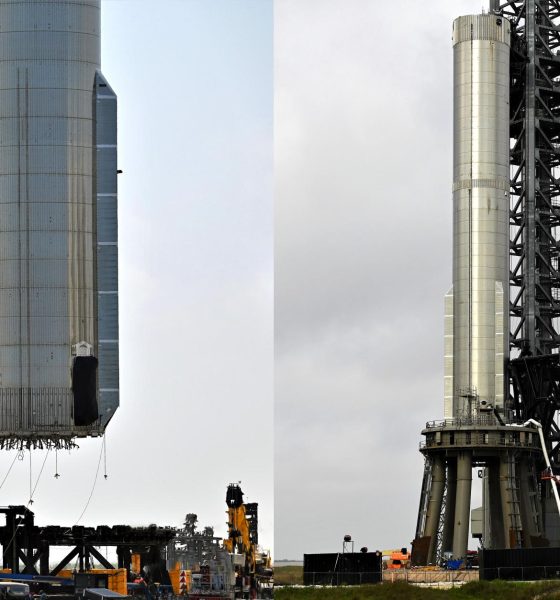
News
SpaceX Super Heavy booster returns to launch pad after major repairs
SpaceX has returned its newest Super Heavy to Starbase’s orbital launch site (OLS) after rapidly repairing damage the booster suffered during its first round of testing.
Super Heavy Booster 7 (B7) left the High Bay it was assembled in for the first time on March 31st and rolled a few miles down the road to nearby Starship launch and test facilities on a set of self-propelled mobile transporters (SPMTs). On April 2nd, the roughly 67-meter-tall (~220 ft; 69m w/ Raptors) rocket was installed on top of Starbase’s lone orbital launch mount (OLM), setting the stage for crucial qualification testing.
The start of that process was exceptionally successful. On April 4th, after a smooth launch mount installation, SpaceX quickly filled Booster 7’s propellant tanks with a relatively benign cryogenic fluid (liquid nitrogen, liquid oxygen, or both) to simulate the thermal and mechanical characteristics of real flammable propellant. Despite the fact that the test marked the first time SpaceX had fully filled a Super Heavy prototype’s tanks, Booster 7 sailed through the ‘cryoproof’ without any obvious issue.
On April 8th, SpaceX moved Super Heavy B7 from the orbital launch mount to a structural test stand that had been installed and modified just a few hundred feet away in the weeks prior. This is where Booster 7’s near-perfect start to qualification testing took a bit of a turn. Booster 7 is only the third full-size Super Heavy prototype SpaceX has tested since July 2021. Like Booster 3 and Booster 4 before it, Booster 7 features some major design changes that ultimately make the prototype a pathfinder, necessitating extensive qualification testing.
To name just a few of the changes, Super Heavy B7 is the first booster fitted with a 33-engine puck and the first finished Starship prototype of any kind designed to use new Raptor V2 engines. With all 33 engines installed and operating a full thrust, Booster 7’s entire structure – and its aft thrust section especially – would be subjected to around 40% more thrust and stress than Booster 4, which indirectly completed structural testing with the help of a sacrificial test tank. Beyond differences in thrust and mechanical stress, Booster 7 is also the first Super Heavy to reach the test stand with secondary ‘header’ tanks meant to store landing propellant.
It’s unclear if those header tanks were fully filled and drained during Booster 7’s cryoproof, but they would not be quite as cooperative during a different kind of cryogenic testing on the structural test stand. The stand SpaceX modified specifically for Super Heavy B7 was outfitted with 13 hydraulic rams to simulate the full thrust of the booster’s central Raptor V2 engines – up to almost 3000 tons (~6.6M lbf) compared to Booster 4’s ~1700 tons (~3.7M lbf) with a smaller cluster of nine engines.
Implosion at the Structural Test Stand
After a few false starts and minor tests on the stand, Booster 7 finally managed some significant testing on April 14th. Judging by the rhythmic shattering of ice that built up on Super Heavy’s tanks, the test stand was able to simulate the thrust of Raptors to some degree and subject the booster to major mechanical stress that was felt from tip to tail. Within a few days, Booster 7 was removed from the test stand and returned to the high bay on April 18th. Around April 21st or 22nd, an image was leaked showing extensive damage inside Booster 7, confirming that the Super Heavy’s test campaign had been forced to end prematurely.
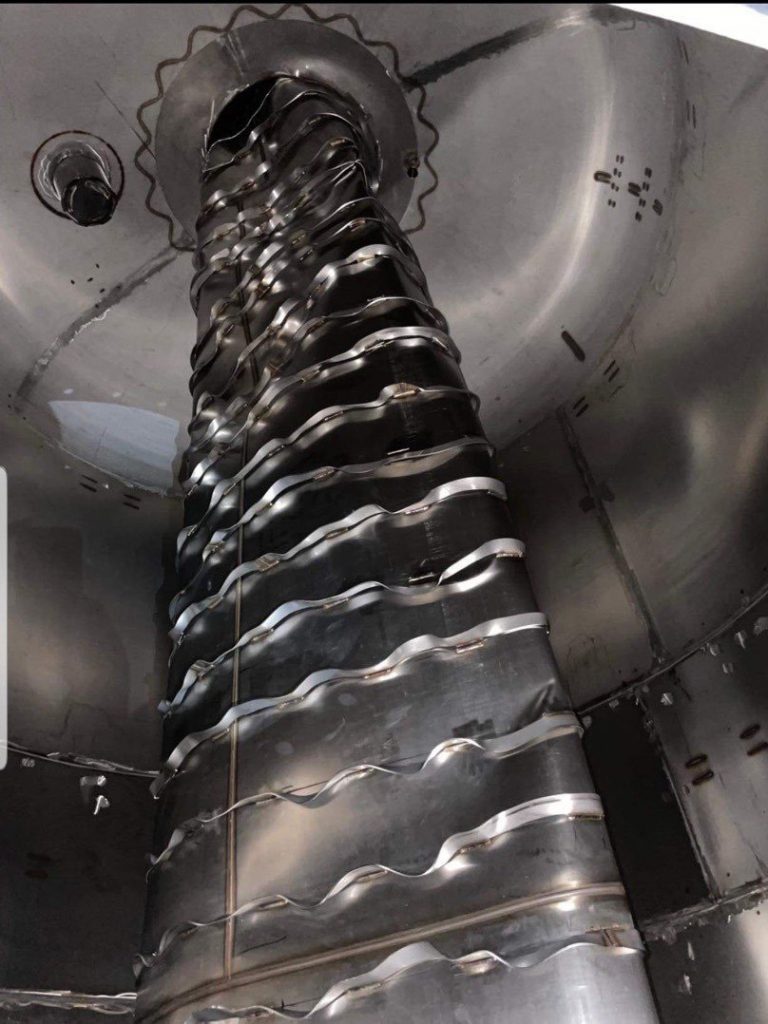
Right away, the damage shown in the photo hinted at an operational failure, meaning that mistakes made by the rocket’s operators may have been more to blame than a possible design flaw. The photo shows a short portion of B7’s liquid methane (LCH4) transfer tube that runs through the booster’s new liquid oxygen (LOx) header tank, which itself sits inside Super Heavy’s main LOx tank at the aft end of the rocket – a tube inside a small tank inside a large tank, in other words. Super Heavy’s LCH4 transfer tube generally does what it says, allowing methane to safely fly down through the main LOx tank and fuel up to 33 Raptor engines. At full thrust, that tube would need to supply around 20 tons (~45,000 lb) of methane per second.
However, on top of merely transferring methane through the oxygen tank, Booster 7 introduced a design change that allows some or all of that tube to change functions and become a header tank mid-flight. That would require a system of valves that could seal off the main LCH4 tank once it was emptied, turning the transfer tube into a sort of giant steel straw filled with enough LCH4 to fuel Super Heavy’s boost-back and landing burns.
The damaged transfer tube in the leaked photo of Booster 7 doesn’t look that unlike what one might expect to see if they sucked through one end of a straw while blocking the other end, collapsing the center. Translated to the scale of Super Heavy, after an otherwise successful day of structural testing, SpaceX operators may have accidentally closed or opened the wrong valves while draining the booster’s transfer tube of liquid oxygen or nitrogen. As the heavy liquid drained from the tube, a lack of pressure equalization could have quickly drawn a vacuum and caused the tube to implode.
On April 29th, a SpaceX fan turned analyst published an analysis that convincingly pinpointed the moment Booster 7’s transfer tube collapsed. Simultaneously, because it showed that the transfer tube likely imploded during detanking, the analysis more or less confirmed the above speculation that the failure had been caused by a degree of operator error or poor test design. Of course, it’s possible that a hardware or software design flaw contributed to or caused the anomaly or that something like a pressure differential in the LOx header tank and LCH4 header tube could also explain the damage, but the accidental formation of a vacuum during detanking is arguably the simplest (obvious) explanation.
After the image of the internal damage leaked, the immediate consensus among fans and close followers was that Booster 7 was beyond repair. Instead, SpaceX appears to have proven those assumptions wrong and somehow managed to repair the upgraded Super Heavy to the point that it was worth testing again less than three weeks after returning to the high bay. On May 6th, B7 was rolled back to the launch site and installed, for the second time, on the orbital launch mount.
Prior to the failure, the general expectation was that SpaceX would begin installing Raptor V2 engines as soon as Booster 7 passed structural testing. It remains to be seen if SpaceX wants to repeat Booster 7’s cryoproof or structural testing to ensure that its quick repairs did the job before proceeding into static fire testing as previously planned. Nonetheless, hope lives on for the Super Heavy prototype and new test windows have been scheduled from 10am to 10pm on May 9th, 10th, and 11th.

News
Man credits Grok AI with saving his life after ER missed near-ruptured appendix
The AI flagged some of the man’s symptoms and urged him to return to the ER immediately and demand a CT scan.

A 49-year-old man has stated that xAI’s Grok ended up saving his life when the large language model identified a near-ruptured appendix that his first ER visit dismissed as acid reflux.
After being sent home from the ER, the man asked Grok to analyze his symptoms. The AI flagged some of the man’s symptoms and urged him to return immediately and demand a CT scan. The scan confirmed that something far worse than acid reflux was indeed going on.
Grok spotted what a doctor missed
In a post on Reddit, u/Tykjen noted that for 24 hours straight, he had a constant “razor-blade-level” abdominal pain that forced him into a fetal position. He had no fever or visible signs. He went to the ER, where a doctor pressed his soft belly, prescribed acid blockers, and sent him home.
The acid blockers didn’t work, and the man’s pain remained intense. He then decided to open a year-long chat he had with Grok and listed every detail that he was experiencing. The AI responded quickly. “Grok immediately flagged perforated ulcer or atypical appendicitis, told me the exact red-flag pattern I was describing, and basically said “go back right now and ask for a CT,” the man wrote in his post.
He copied Grok’s reasoning, returned to the ER, and insisted on the scan. The CT scan ultimately showed an inflamed appendix on the verge of rupture. Six hours later, the appendix was out. The man said the pain has completely vanished, and he woke up laughing under anesthesia. He was discharged the next day.
How a late-night conversation with Grok got me to demand the CT scan that saved my life from a ruptured appendix (December 2025)
byu/Tykjen ingrok
AI doctors could very well be welcomed
In the replies to his Reddit post, u/Tykjen further explained that he specifically avoided telling doctors that Grok, an AI, suggested he get a CT scan. “I did not tell them on the second visit that Grok recommended the CT scan. I had to lie. I told them my sister who’s a nurse told me to ask for the scan,” the man wrote.
One commenter noted that the use of AI in medicine will likely be welcomed, stating that “If AI could take doctors’ jobs one day, I will be happy. Doctors just don’t care anymore. It’s all a paycheck.” The Redditor replied with, “Sadly yes. That is what it felt like after the first visit. And the following night could have been my last.”
Elon Musk has been very optimistic about the potential of robots like Tesla Optimus in the medical field. Provided that they are able to achieve human-level articulation in their hands, and Tesla is able to bring down their cost through mass manufacturing, the era of AI-powered medical care could very well be closer than expected.
News
Tesla expands Model 3 lineup in Europe with most affordable variant yet
The Model 3 Standard still delivers more than 300 miles of range, potentially making it an attractive option for budget-conscious buyers.
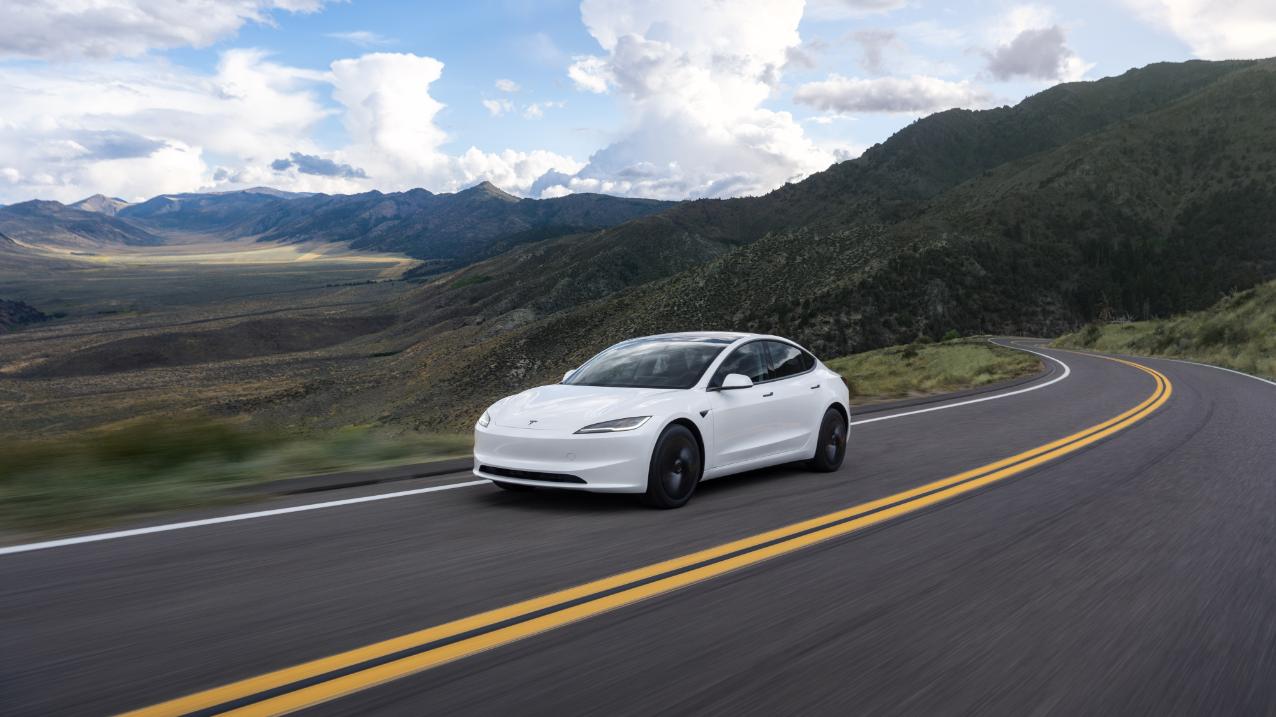
Tesla has introduced a lower-priced Model 3 variant in Europe, expanding the lineup just two months after the vehicle’s U.S. debut. The Model 3 Standard still delivers more than 300 miles (480 km) of range, potentially making it an attractive option for budget-conscious buyers.
Tesla’s pricing strategy
The Model 3 Standard arrives as Tesla contends with declining registrations in several countries across Europe, where sales have not fully offset shifting consumer preferences. Many buyers have turned to options such as Volkswagen’s ID.3 and BYD’s Atto 3, both of which have benefited from aggressive pricing.
By removing select premium finishes and features, Tesla positioned the new Model 3 Standard as an “ultra-low cost of ownership” option of its all-electric sedan. Pricing comes in at €37,970 in Germany, NOK 330,056 in Norway, and SEK 449,990 in Sweden, depending on market. This places the Model 3 Standard well below the “premium” Model 3 trim, which starts at €45,970 in Germany.
Deliveries for the Standard model are expected to begin in the first quarter of 2026, giving Tesla an entry-level foothold in a segment that’s increasingly defined by sub-€40,000 offerings.
Tesla’s affordable vehicle push
The low-cost Model 3 follows October’s launch of a similarly positioned Model Y variant, signaling a broader shift in Tesla’s product strategy. While CEO Elon Musk has moved the company toward AI-driven initiatives such as robotaxis and humanoid robots, lower-priced vehicles remain necessary to support the company’s revenue in the near term.
Reports have indicated that Tesla previously abandoned plans for an all-new $25,000 EV, with the company opting to create cheaper versions of existing platforms instead. Analysts have flagged possible cannibalization of higher-margin models, but the move aims to counter an influx of aggressively priced entrants from China and Europe, many of which sell below $30,000. With the new Model 3 Standard, Tesla is reinforcing its volume strategy in Europe’s increasingly competitive EV landscape.
News
Tesla FSD (Supervised) stuns Germany’s biggest car magazine
FSD Supervised recognized construction zones, braked early for pedestrians, and yielded politely on narrow streets.
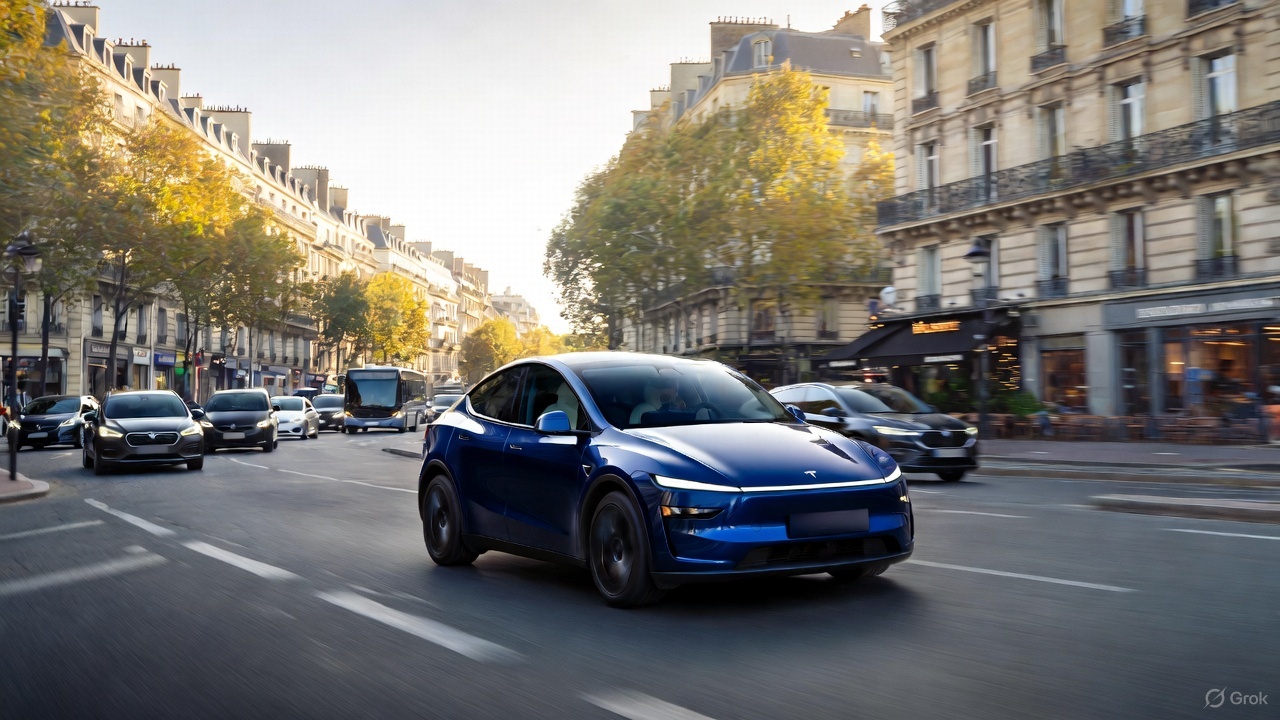
Tesla’s upcoming FSD Supervised system, set for a European debut pending regulatory approval, is showing notably refined behavior in real-world testing, including construction zones, pedestrian detection, and lane changes, as per a recent demonstration ride in Berlin.
While the system still required driver oversight, its smooth braking, steering, and decision-making illustrated how far Tesla’s driver-assistance technology has advanced ahead of a potential 2026 rollout.
FSD’s maturity in dense city driving
During the Berlin test ride with Auto Bild, Germany’s largest automotive publication, a Tesla Model 3 running FSD handled complex traffic with minimal intervention, autonomously managing braking, acceleration, steering, and overtaking up to 140 km/h. It recognized construction zones, braked early for pedestrians, and yielded politely on narrow streets.
Only one manual override was required when the system misread a converted one-way route, an example, Tesla stated, of the continuous learning baked into its vision-based architecture.
Robin Hornig of Auto Bild summed up his experience with FSD Supervised with a glowing review of the system. As per the reporter, FSD Supervised already exceeds humans with its all-around vision. “Tesla FSD Supervised sees more than I do. It doesn’t get distracted and never gets tired. I like to think I’m a good driver, but I can’t match this system’s all-around vision. It’s at its best when both work together: my experience and the Tesla’s constant attention,” the journalist wrote.
Tesla FSD in Europe
FSD Supervised is still a driver-assistance system rather than autonomous driving. Still, Auto Bild noted that Tesla’s 360-degree camera suite, constant monitoring, and high computing power mark a sizable leap from earlier iterations. Already active in the U.S., China, and several other regions, the system is currently navigating Europe’s approval pipeline. Tesla has applied for an exemption in the Netherlands, aiming to launch the feature through a free software update as early as February 2026.
What Tesla demonstrated in Berlin mirrors capabilities already common in China and the U.S., where rival automakers have rolled out hands-free or city-navigation systems. Europe, however, remains behind due to a stricter certification environment, though Tesla is currently hard at work pushing for FSD Supervised’s approval in several countries in the region.








